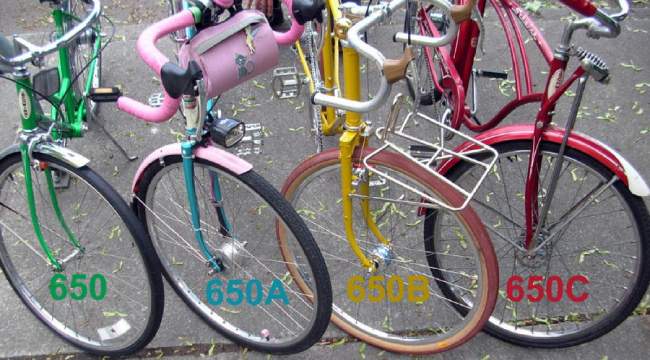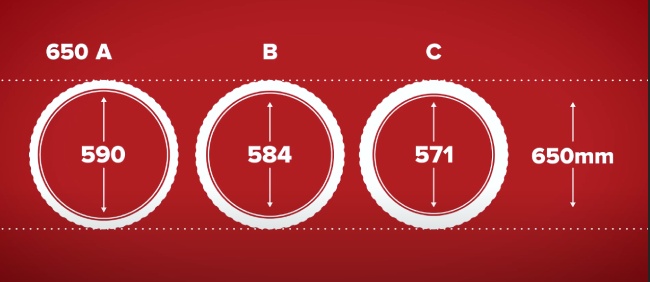650 tires are being increasingly popular day by day. As opposed to the standard road wheels (700C), 650 wheels provide slightly better traction and manueverability over rough terrains. However, there are a couple of variation of the 650 wheels to choose from; The 650B and 650C are the most widely known among them.
If you’re a fan of 650 wheels and want to select the best-performing wheels for you, look no further. We’re here today to discuss the aspects that draw out the best performance from each wheel. Join us as we dive deep into a details 650b vs 650c comparison and find the perfect bike wheel for your needs.
What is 650B?
650B is a dedicated mountain bike tire that is smaller than regular road tires. With a inner diameter of 584 mm, these tires are usually accompanied by wider/fatter tires. They provide excellent grip and traction over rought terrains. For comparison, the 650B tires are larger than 26” wheels, but smaller than 29” wheels.
What is 650c?
The 650C is even smaller then the 650B. With a diameter of 571 mm, the 650C wheels are primarily used for road biking. They can contain higher air pressure, maintaining a rigid shape of the wheel and provides better aerodynamic advantage. However, they’re wider than most racing wheels.
650B vs 650C: What’s the Difference

**Photo Courtesy: Sheldonbrown
Let’s dive into our head-to-head comparison and find out the perfect wheels for your bike.
Radius

**Photo Courtesy: YouTube
This is the biggest issue. If you’re asked, which on is larger, a 26” wheel or a 29” wheel, I’m sure you’ll have no problem answering that. The standard system of measuring bike wheels has constructed a system where it’s easy for everyone to figure out the right size parts. For example, if anyone ever asks you how to find the bigger wheels, you’ll probably suggest comparing the rim diameters, right?
Unfortunately, that trick doesn’t work always. The previous most popular way of measuring (the french method) wheels features the whole diameter as the base and adjust the tire accordingly. Here’s an image to help you visualizer better.
As per the image, 650 series tires all have a base diameter of 650 mm. The letter on the 2nd part of the wheel’s name refers to the width of the tire. So, 650A tire is thinner than 650B, which is even thinner than 650C wheels.
Here’s no winner as different wheels perform distinctively in different situation. A 650B wheel will provide greate stability and manueverability over rough terrains, whereas a 650C wheels will provide speed and control over gravel roads.
Stability
As you’ve probably guessed by now, the 650B tires provide slightly better stability. However, the comparison woildn’t be fare because riding over a rough terrain isn’t the same with cruising over hard surfaces (like road). So, we tested both wheels under different circumstances, and hers’s the result:
The wider tire can allow lower air pressure inside the tire, which increases the contact patch of the tire. Contact patch means how much of your tire is gripping against the road. The larger the contact patch (650B) is, the easier will it be for you to control the bike.
On the other hand, smaller wheels with bigger rims (650C) have shorter contact patch, making it harder to control your bike when you’re riding at a higher speed.
Aerodynamics
The wider contact patch makes the 650B is less aerodynamic than the 650C. The 650B wheels provide better traction than 26” wheels, but can’t outperform the 29” wheels or 650C. However, the environment they’re used are vastly different.
On a gravel road, the less aerodynamic 650B will make it harder to control the bike, especially when you’re riding at a high speed. 650C wheels will have better control here.
On the flipside, if you’re trekking uphill/downhil, you’ll hardly have the opportunity to ride fast. You’ll be occupied with sharp turns, small debris, and unexpected holes. In this low-speed conditions, a fat (650B) tire will come in handy as you’ll have better control over the bike.
Speed
Here’s a tricky one. As the ideal conditions of using 650B and 650C wheels are different, the comparison of speed varies person to person.
Of cource, on a gravel road, the 650C will have an advantage in speed and aerodynamics, the 650C wheels compensates for that with great manuaverablity and control over rough terrains.
With provide better traction and stabilit, the 650B tires can easily roll over obstacles. They’ll also soak up the lumps and bumps better than the 650C tires. On the other hand, the lightweight 650C beats the 650B in terms of speed & weight.
Here’s a video guide showing the difference between a larger and a smaller bike wheels in action:
Usage
To summurize, both 650B and 650C are built for and used in different landscapes. 650B wheels are champion on mountain biking and trekking whereas the 650C tires rule the asphalt roads. Both of them are high volume tires that are suited for different environmants.
If you’re a mountain bikers looking for a bit better traction and manueverablity in your rides, go for the 650B wheels and if you want regular commuting over concrete ground, or compete in a race, the 650C would be a better choice.
However, the model 650C is being replaced by the current road standard, 700C wheels. Here are the key differenced between 650B and 650C tires, if you’re interested:
| Subject | 650B | 650C |
| Weight | Heavy (545.00 g) | Lighter (515.00 g) |
| Diameter | 584 mm (bigger) | 571 mm (smaller) |
| Air Pressure | Lower | Higher |
| Tire Profile | Shorter | Taller |
| Contact Patch | Bigger | Slightly smaller |
| Rolling Resistance | Less | High |
| Pucnture Protection | High | Low |
650c to 650b Conversion: How to do
The 650B and 650C arn’t interchangeable, meaning you can’t use the same tire in both cases without adjusting the hub bearings, rims and spokes.
However, you can easily transform your shorter 650C wheels into 650B tires. All you have to do is adding a little bith of spoke length to the wheel. Adding 3mm in spoke length will be sufficient. Just measure the ERD (Effective Rim Diameter) and add spoke length accordingly, and you’re done.







